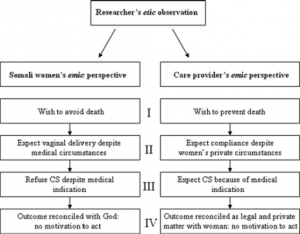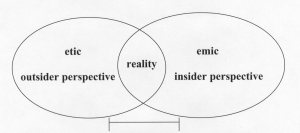Problems in society arise, in part, because of a clash in viewpoints. People are all raised under their own unique conditions, causing them to see the world in certain ways. If a person has been raised in a certain culture they will adopt the opinions of that culture. Conflict arises when people with differing opinions clash. No one person thinks exactly like anyone else so as long as people are only able to understand their own ideas conflict will continue to occur.
Problems in trying to help other people, such as in a psychiatrist patient relationship, crop up when differing perspectives don’t reconcile with each other. If a psychiatrist uses only an etic approach with his or her patients he or she will hold preconceived notions that will affect how he or she interacts with his or her patients and his or her ability to help them. The psychiatrist will make inferences that fit the patients into a ready-made mold and diagnose them according to this mold as well. A fully etic approach creates stereotypes leading to conflicts between cultures, races, educational levels, etc. This approach leads to other misconceptions as well, such as the idea that a homeless man would need a one hundred dollar pair of shoes and the idea that he is ungrateful for not wearing those shoes.

An anthropological analysis of the perspectives of Somali women in the West and their obstetric care providers on caesarean birth
An ideal approach to prevent disputes between people is the emic approach that allows you to understand others thought processes. Adopting others’ emic ideas and gaining and understanding of their thought processes is important. Understanding how and why people do the things they do lessens the amount of complications. It is very difficult adopt this approach entirely, however; in some cases, it is impossible. It is, therefore, more beneficial to take an etic-emic approach. This is a blend between the two perspectives that allows a person to have a rounder, fuller understanding of both sides of a story.

A Venn diagram of the two different types of perspectives people may adopt, showing that it is possible to overlap them
One step to fixing world problems is by trying to look through other people’s eyes and understand how they see the world. Conflict will always occur because it is impossible to get everyone to agree on everything. Problems would be better resolved, however, if people tried harder to understand each other’s perspectives.
Sources
http://openi.nlm.nih.gov/imgs/512/92/3055712/3055712_dpog32-010-f1.png
http://www.ohio.edu/people/thompsoc/reality.gif
http://www.intentionalitymodel.info/pdf/UXBRIDGE.pdf
Additional Reading
http://www.sciencedirect.com/science/article/pii/S0962184900800086#
http://openi.nlm.nih.gov/detailedresult.php?img=3055712_dpog32-010-f1&req=4
http://www.jstor.org/stable/2949316
http://www.intentionalitymodel.info/pdf/UXBRIDGE.pdf

It is important to be able to respect and communicate across different. There is no way that everyone you encounter’s experiences or perspectives will align exactly with yours and, as a result, the etic-emic approach is necessary. I am curious about how the etic-emic approach manifests itself not only between an archaeologist and the community they study, but also within the archaeological academic community. How do archaeologists who study similar things, but approach them from vastly different perspectives/draw different conclusions interact?